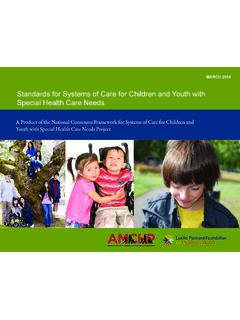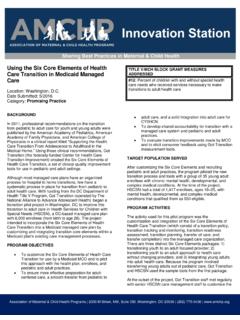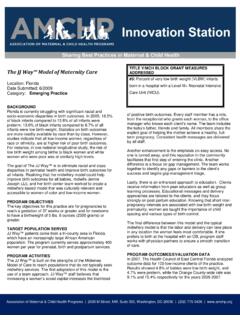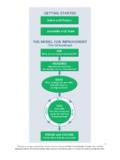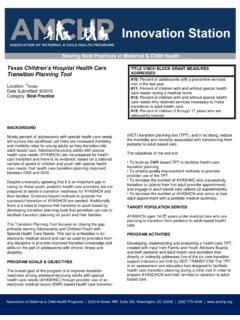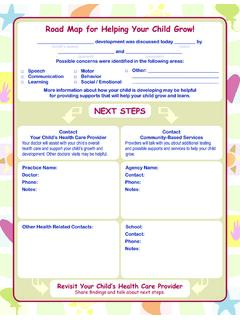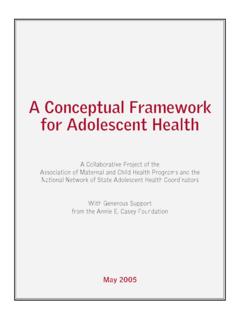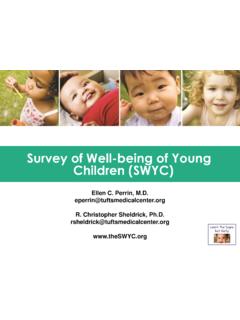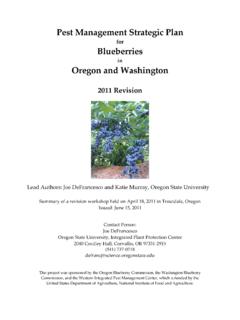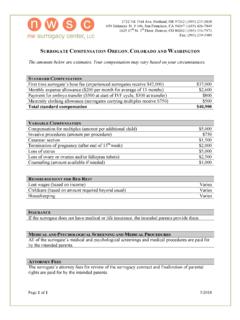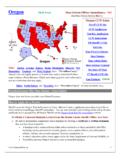Transcription of TITLE V/MCH BLOCK GRANT MEASURES Oregon …
1 Association of Maternal & Child Health programs | 2030 M Street, NW, Suite 350, Washington, DC 20036 | (202) 775-0436 | Oregon youth transition Program Location: Oregon Date Submitted: 12/2009, updated 5/2011 Category: Best Practice BACKGROUND Over the last two decades, there has been a national effort to develop effective secondary transition practices and to improve post school outcomes for youth and young adults with disabilities. The Individuals with Disabilities Education Improvement Act of 2004 (IDEA) included an emphasis on transition planning for all youth receiving special education services and emphasized that the fundamental purpose of a free appropriate education is to prepare youth for further education, employment, and independent living.
2 Although progress has been made, youth with disabilities still face multiple barriers when preparing to transition to productive adult roles in the community. Overall employment rates for people with disabilities are significantly lower than those without disabilities. A National Organization on Disability ( )/Harris Survey of Americans with Disabilities poll reported that 35% of people with disabilities were employed full or part-time compared with 78% of people without disabilities. youth with disabilities also lag far behind their peers without disabilities in school completion, and participation in post secondary education. Oregon s youth transition Program (YTP) is a comprehensive transition program for youth with disabilities implemented by the Oregon Office of Vocational Rehabilitation Services (OVRS), Oregon Department of Education, University of Oregon , and local school districts statewide in Oregon .
3 The purpose of the program is to prepare youth with disabilities for employment or career related post secondary education or training. Staff may also assist participants in need seek health care and mental health services within the community. The program currently exists in 105 high schools and is funded through a combination of state and local funds from participating education and rehabilitation agencies. Participants have demonstrated consistently positive educational and employment outcomes. PROGRAM OBJECTIVES YTP has two distinct yet interconnected goals. The first goal is to improve post school transition outcomes for youth with disabilities by preparing them for employment or career related post secondary education/training. The second goal is to increase capacity and create systems change in schools and other agencies serving students with disabilities in transition from school to work.
4 TARGET POPULATION SERVED This practice is currently operating statewide in Oregon , serving 1,432 youth with disabilities in 105 high schools. YTP sites include both rural and urban communities, with large and small high schools. Since 1990, over 12,000 youth with disabilities have received YTP services. PROGRAM ACTIVITIES The purpose of the youth transition Program is to provide a new pattern of services to students with disabilities beginning when they are still in high school and continuing into the early transition years. In each participating school district, YTP services are provided jointly by a transition Specialist and a local Vocational Rehabilitation Counselor. Students participating in the YTP receive (a) individualized planning, focused on post school goals and self determination and help to coordinate school plans with relevant community agencies, (b) instruction in academic, vocational, independent living, and personal social skills and help to stay in and complete high school, (c) career development services including goal setting, career exploration, job search skills, and self advocacy, (d) paid employment including connections with local employers, on the job assessments, placement and training, (e) Support services such as individualized mentoring and support or referrals for additional specific interventions, and (f)
5 Follow-up support for one year after leaving the program to assist in maintaining positive outcomes in employment or post secondary settings. TITLE V/MCH BLOCK GRANT MEASURES ADDRESSED #12:Percent of children with and without special health care needs who received services necessary to make transitions to adult health care. Oregon youth transition Program 2 | P a g e INNOVATION STATION | Sharing Best Practices in MCH Program staff also provides wrap around services by assisting those with physical disabilites and mental health issues such as anxiety or depression to obtain the care they need using community health providers.
6 PROGRAM OUTCOMES/EVALUATION DATA Extensive data were collected to document both the short term and long term outcomes associated with participation in the YTP. YTP data are entered into a secure web based data system developed and monitored by the University of Oregon . Short term outcomes measured include high school graduation and engagement in either employment or post school training upon program completion. Long term outcomes include 6 and 12 month follow up data to measure ongoing engagement over time in either employment or training. In addition to measuring individual outcomes for youth , overall site performance is tracked and monitored using a set of performance benchmarks developed by the Oregon OVRS. Sites must demonstrate positive progress and quality transition outcomes in order to receive continuation funding.
7 Over the last ten years, the program has documented: (a) increased collaboration and referrals to vocational rehabilitation, (b) development of individualized employment plans, (c) improvements in high school graduation rates, (d) positive employment outcomes ( wages, hours worked per week) and (e) engagement in either competitive employment or career related post school training at exit, 6 months and 12 months after high school PROGRAM COST YTP utilizes a combination of education and rehabilitation funds. Local schools apply to participate in the YTP model through a competitive request for proposal process. Successful schools submit matching funds and receive a GRANT from OVRS to develop and implement the program. GRANT funds are used to support the salary of the transition Specialists, travel, costs to attend YTP training events, and other operating expenses.
8 Estimated cost per client is $3,000. ASSETS & CHALLENGES Assets At the time the YTP was being launched supported employment programs for students with significant disabilities were just beginning to be developed with support from external GRANT funds OVRS administrators recognized the value of a creating a collaborative transition system to promote more positive employment and rehabilitation outcomes. Challenges One of the primary challenges to implementing the YTP initially was to coordinate service delivery across two very different systems special education and rehabilitation. A second challenge was creating a flexible transition service delivery models within public high schools that were operating in a traditional academic structure. Unemployment rates across Oregon soared in the last year making the job market much more difficult for young workers with disabilities.
9 As of May 2009, Oregon s seasonally adjusted unemployment rate was %, the highest unemployment rate on record since 1976. Overcoming Challenges This program has overcome challenges by proactively using patnerships and available expertise to problem solve and provide resources to local YTP sites. Additionally, local sites participate in yearly training events and receive e-mail, phone and on site technical assistance to address site specific issues and barriers to program implementation. LESSONS LEARNED transition for youth necessitates collaboration between service providers at multiple levels ( , public schools, Office of Vocational Rehabilitation, State Departments of Education, community. colleges, etc.) on a consistent, ongoing basis.
10 Collaborative funding and dedicated staff time is critical for ongoing sustainability of efforts. Young adults need extensive career exploration, career development, job training and support to assist them in obtaining meaningful employment. Ongoing technical assistance and training is needed to facilitate collaborations between stakeholders, meet the needs of specific populations and create capacity within local schools and rehabilitation offices. FUTURE STEPS The YTP model is currently a line item in the OVRS state budget. Funds are allocated to continue to support contracts to local YTP sites as well as a biennial Training and Technical Assistance contract with the University of Oregon . COLLABORATIONS This practice is a collaborative effort among Oregon Vocational Rehabilitation Services (OVRS), Oregon Department of Education (ODE), the University of Oregon and local school districts in Oregon .

